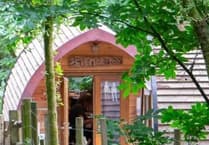YOUR article on the back page of the edition of August 28, quoted Penny Mills of the Campaign for the Protection of Rural England. She finishes by saying that the impact of wind turbines can be seen for miles and that they are a blot on the landscape. I think she should get her sense of perspective right. The Bondleigh wind turbine can be seen from some parts of Winkleigh, which is just about two miles away. It's actually quite difficult to spot as it's almost lost in the backdrop of Dartmoor. If you hold your thumb out at arm's length you can more than completely cover it. Even in Bondleigh the turbine isn't that visible as the hills and vales, hedge- rows and trees cover it quite well. This is no comfort for a couple of Bondleigh residents who live within about 600 metres of the structure. I think that given the developers had a large field to put it in, they might have been able to lessen the visual impact for them and a little more local involvement might have been possible here. Having said that, the planning for the turbine was discussed at properly called, well attended parish meetings in both Bondleigh and Sampford Courtenay and both voted in favour of the application. Driving around the local roads between Bondleigh, Winkleigh, Monkokehampton and North Tawton as I do, I've had a good look out for the turbine and have been generally impressed with how little it shows up, even from the elevated position of a 110 Land Rover which allows me to see over the hedgerows most other motorists can't see through. Obviously the most outstanding view is from the Winkleigh to North Tawton road, but even there it's often not clearly visible. When it's at its biggest and most obvious it is also soon passed by and it doesn't long stand in front of the impressive sweep of Dartmoor which is still much to be enjoyed. I was also interested to note how little the Jacobstowe balloon showed up, driving to Hatherleigh when it was being flown and going all round the roads surrounding the proposed siting. It should be mandatory for the companies proposing to erect turbines to fly a balloon the size and shape of the top 15 to 20 feet of their blades. Such a move would give us all a much more accurate impression of their impact and probably reduce the scare stories people put about in opposition. Most visitors experience the local views from their cars and they will have seen wind turbines all over the country. They are now quite widespread so their existence in Devon is hardly likely to put many people off coming. Personally I think the biggest problem for the search for acceptable energy sources is that we haven't accepted that we need more storage to cover peak demand. This is probably easier for small producers like wind turbines which could easily have battery back up systems either within the turbine towers or next to them, ready for a Smart National Grid to draw the power when required in the locality. Since our demand for power varies so much — between 22 units at low demand during summer nights, to 57 at 5pm to 7pm of a winter's evening — it's incredibly wasteful to have generating capacity to cover the latter for only two hours when a storage system could boost the supply from intermittent generation such as wind, water or tidal sources. John Warre Bondleigh North Tawton
WE are writing to express our concern over the proposed erection by Murex Energy Ltd of a wind turbine at Wreys Barton, Stowford and the way it is apparently being dealt with by West Devon Council. On September 9 we attended a meeting in Stowford Village Hall where Murex outlined its plans for a 50 metre tower (77 metre to rotor tip) wind turbine rated at 500Kw. We understand that it has applied to West Devon Council for a screening opinion as to whether an environmental report or an environmental impact assessment is required by the council. We would point out that Government guidance for a turbine of 50 metres or more is that one or other of these should be produced. There appears to be some concern over lack of consultation with, and accurate information provided to, local parish councils and residents. For example, when was this request, which has to be answered within three weeks, received by the council? Was any attempt made to consult locally? Has the council responded confirming the need for an EIS? if so, has it been asked for and provided a scoping opinion which has to be replied to within five weeks and has a copy of this been provided to the public? At this meeting Murex accepted that insufficient consultation by itself had taken place with residents and agreed to extend its consultation period to the end of September. The company confirmed that the turbine could be rated to produce 990Kw but would be capped at a maximum of 500Kw. A reason given was reduced noise pollution. Interestingly no-one could say if one turbine rated at 990 Kw was noisier than two rated at 500Kw. Challenged that the capping at 500Kw was to capitalise on the much higher subsidy for turbines of 500Kw or less, the company did not deny it. Two of the main consequences of this capping are firstly that the environmental impact is doubled as effectively twice as many turbines have to be built to achieve the same power generation and secondly the power generated costs at least twice as much per Kw as it should. We would also draw to your attention the dissatisfaction expressed at the meeting with the planning department. We understand that a number of communications from Stowford Parish Council and others have not been responded to and the general opinion of those present was the department was a law unto itself and had little regard for those it served. Another disquieting issue was that, despite being invited to the meeting, nobody from the council attended. We would also point out that when searching the council's website using the term 'Wind turbines' it brings up a list of documents one of which is the 'Interim Planning Guidance for Prospective Developers'. Interestingly, the document states that: 'Permission will only be granted if the developer has satisfactorily addressed the following on an individual case by case basis: The use of the most appropriate technology; measures to mitigate any adverse impacts on the amenities of the occupiers of nearby properties during the construction, operational lifespan and decommissioning of the equipment/infra-structure, and the provision for the protection, preservation, and/or mitigation for any features of strategic, cultural, agricultural, ecological, historic and/or archaeological importance, including landscape character.' The above would all appear to be in conflict with the issue of size and potential generation of both the existing and proposed turbines. It is interesting to note the written statement to parliament 'Local planning and onshore wind' by the Rt Hon Eric Pickles MP of June 6, 2013 and subsequent documents and statements giving more power to local communities to decide on these matters and in addition 'Calling In' and subsequently refusing many of the applications relating to wind turbines. Richard and Karen Alexander Lewdown
THE frontpage headline on September 4 should be a wake up call to us all, but most of all to the West Devon borough councillors who have not stirred themselves to attend either the Lewdown meeting on September 1 or the Stowford meeting on September 9, both of which were full to overflowing. Strong sentiment was expressed against the Murex proposed development in the area which would affect some of the most beautiful and traditional West Devon landscape across the Thrushel valley. A new group called SALT (Stowford And Lewdown Turbine action group) has been set up and is fiercely opposed to the project. If I was a councillor elected to serve his consituents, I would at this time be feeling most uncertain about my future chances of being re-elected. The feeling in Stowford village hall on Tuesday was that people were being abandoned by their representatives and purposefully ignored by the West Devon planning officers and committee. Murex did on this occasion raise their heads above the parapet and attend the meeting. Their proposals and responses to questions met with vigorous opposition despite the offer of a bigger than usual bribe by way of a donation to the community. People locally obviously do not want to live in a blighted landscape such as those seen in Cornwall. It was agreed by those in attendance that global warming had to be met with green policies but that the haphazard spread of wind turbines was not the answer, especially not in the Stowford/Lewdown area and hopefully nowhere in West Devon. Mike Harding Stowford Old Rectory Lewdown




Comments
This article has no comments yet. Be the first to leave a comment.